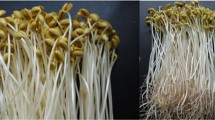Abstract
-
1.
Measurements were made of stem length, leaf number, leaf size, total yield and marketable yield on two varieties of Brussels sprout, on inbred lines derived from them, and on hybrids produced by crossing the inbred lines of the two varieties.
-
2.
Three sets of such measurements were taken at different periods in the growing season. The standard errors of plot totals decreased with increasing plant maturity, but the standard errors of the within-plot variances were not affected.
-
3.
Inbreeding depression varied considerably in degree, both between different inbred lines and between different characters in the same line, and ranged from a 5 per cent. reduction in number of leaves to a 58 per cent. reduction in marketable yield, as compared with the parent non-inbred varieties.
-
4.
Hybrid vigour varied in a similar manner, but all hybrid families gave yields which exceeded that of the highest yielding parent variety.
-
5.
In every hybrid family studied, the increase in the marketable yield, as compared with the mean of the parent varieties, was greater than the increase in any other character including total yield. It is suggested that this was the result of selection during inbreeding, for uniformity of desirable sprout quality.
-
6.
Analysis of the within-plot variances of the characters measured suggested that uniformity for plant and leaf size characters had not been markedly changed by inbreeding.
-
7.
The contrast between increased uniformity for sprout quality and lack of detectable change in uniformity for plant and leaf size characters is attributed to different rates of approach to homozygosis at different loci as a result of selection.
-
8.
Inbred lines can combine to produce hybrid families with yields superior to those of the non-inbred parent varieties. Work is continuing on both the breeding and assessment of inbred lines, and on the technical problems involved in the production of hybrid seed in commercial quantities.
Similar content being viewed by others
References
Bateman, A. J. and Mather, K., The progress of inbreeding in barley. Heredity 5 (1951): 321–348.
Haldane, J. B. S., The conflict between inbreeding and selection. I. Self-fertilization. J. Genet. 54 (1956): 56–63.
Hayman, B. I. and Mather, K., The progress of inbreeding when homozygotes are at a disadvantage. Heredity 7 (1953): 165–183.
Hayman, B. I. and Mather, K., Inbreeding when homozygotes are at a disadvantage: a reply. Heredity 10 (1956): 271–274.
Lewis, D., Gene-environment interaction: a relationship between dominance, heterosis, phenotypic stability and variability. Heredity 8 (1954): 333–355.
Ministry of Agriculture, Fisheries and Food, London, National Recommended Grades for Home Grown Brussels Sprouts. Marketing guide 6 (1956).
North, C. and Frith, L. H., An instrument for measuring the firmness of Brussels sprouts. J. hort. Sci. 34 (1959): 183–188.
Author information
Authors and Affiliations
Rights and permissions
About this article
Cite this article
Johnson, A.G. Assessment of vigour and uniformity in Brussels sprouts. Euphytica 9, 338–350 (1960). https://doi.org/10.1007/BF00029486
Received:
Issue Date:
DOI: https://doi.org/10.1007/BF00029486




